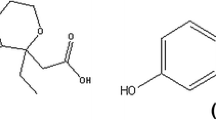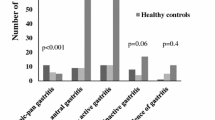Abstract
Nimesulide, a non-steroidal, anti-inflammatory drug, produces ulcerogenic effects in adrenalectomized rats but is gastro-protective in intact rats. The objective of this study was to determine whether adrenal gland hormones are involved in the anti-ulcer effects of nimesulide. The results revealed that 100 mg/kg nimesulide produces gastric ulceration in adrenalectomized rats, which is prevented by prednisolone and adrenaline. The anti-ulcer effects of adrenaline and prednisolone in adrenalectomized rats were in turn antagonized by yohimbine, a selective α2-receptor blocker, but not by doxazosine (α1-receptor blocker) or propranolol (β-blocker). Adrenaline prevented the formation of indomethacin-induced ulcers in both adrenalectomized and intact rats, but prednisolone increased the indomethacin-induced ulcerous area in intact rats, whereas it decreased the size of the ulcers in adrenalectomized rats. In addition, prednisolone prevented ulcer formation in intact rats in which the adrenaline concentration had been decreased by metyrosine. These results suggest that glucocorticoids are anti-ulcerogenic in not only adrenalectomized rats but also in intact rats with diminished circulating levels of adrenaline. In the light of these data, the effect of nimesulide on plasma adrenaline concentrations was studied. In comparison to the adrenaline levels found in intact control rats, the administration of nimesulide at doses of 10, 20, 40 and 100 mg/kg decreased adrenaline concentrations by 12.8, 22.6, 30.4, and 58.2%, respectively, without affecting blood corticosterone concentrations. The anti-ulcer effect of nimesulide was observed to be dose-dependent, and the strength of this effect was directly correlated the decreasing concentration of adrenaline. The concentration of adrenaline was decreased by 60.9% in rats treated with 300 mg/kg metyrosine in which prednisolone produced anti-ulcer effects. In summary, we have shown that nimesulide produces its anti-ulcer effect by decreasing endogenous adrenaline concentrations and that glucocorticoids may induce anti-ulcer effects via α2-adrenoreceptors, but not via their own receptors.
Similar content being viewed by others
References
Abdulla D, Renton KW (2005) β-adrenergic receptor modulation of the LPS mediated depression in CYP1A activity in astrocytes. Biochem Pharmacol 69:741–750
Bailey JM (1991) New mechanisms for effects of anti-inflammatory glucocorticoids. Biofactors 3:97–102
Black HE (1988) The effects of steroids upon the gastrointestinal tract. Toxicol Pathol 16:213–222
Borer JS, Simon LS (2005) Cardiovascular and gastrointestinal effects of COX-2 inhibitors and NSAIDs: achieving a balance. Arthritis Res Ther 7[Suppl]:S14–S22
Burke A, Smyth E, Fitzgerald GA (2006) In: Brunton L (ed) Godman and Gilman’s the pharmacological basis of therapeutics. McGraw Hill, New York, pp 671–717
CCAC (1993) Canadian Council on Animal Care. Guide to the care and use of experimental animals, vol. I, 2nd edn. Bradda Printing Services, Ottawa, Ont., Canada
Del Soldato P (1986) Gastric lesion-preventing or -potentiating activity of clonidine in rats. Jpn J Pharmacol 41:257–259
Di Joseph JF, Eash JR, Mir GN (1987) Gastric antisecretory and antiulcer effects of WHR1582A, a compound exerting alpha-2 adrenoceptor agonist activity. Pharmacol Exp Ther 241:97–102
Filaretova LP, Filaretov AA, Makara GB (1998) Corticosterone increase inhibits stress-induced gastric erosions in rats. Am J Physiol 274:G1024–G1030
Filaretova L, Tanaka A, Komoike Y, Takeuchi K (2002a) Selective cyclooxygenase-2 inhibitor induces gastric mucosal damage in adrenalectomized rats. Inflammopharmacology 10:413–422
Filaretova L, Tanaka A, Miyazawa T, Kato S, Takeuchi K (2002b) Mechanisms by which endogenous glucocorticoid protects against indomethacin-induced gastric injury in rats. Am J Physiol Gastrointest Liver Physiol 283:G1082–1089
Fulop K, Zadori Z, Ronai AZ, Gyires K (2005) Characterisation of alpha2-adrenoceptor subtypes involved in gastric emptying, gastric motility and gastric mucosal defence. Eur J Pharmacol 528:150–157
Gullen L, Kelly L, Connor SO, Fitzgerald DJ (1988) Selective cyclooxygenase-2 inhibition by nimesulide in man. J Pharmacol Exp Ther 287:578–582
Gyires K, Mullner K, Furst S, Ronai AZ (2000) Alpha-2 adrenergic and opioid receptor-mediated gastroprotection. J Physiol Paris 94:117–121
Hawkey CJ (2000) Nonsteroidal anti-inflammatory drug gastropathy. Gastroenterology 119:521–535
Hoffman BB (2006) Therapy of hypertension. In: Brunton L (ed) Godman and Gilman’s the pharmacological basis of therapeutics. McGraw Hill, New York, pp 845–897
Kagitani S, Ueno H, Hirade S, Takahashi T, Takata M, Inoue H (2004) Tranilast attenuates myocardial fibrosis in association with suppression of monocyte/macrophage infiltration in DOCA/salt hypertensive rats. Hypertension 22:1007–1015
Kargman S, Charleson S, Cartwright M, Frank J, Riendeau D, Mancini J, Evans J, O’Neill G (1996) Characterization prostaglandin G/H synthase 1 and 2 in rat, dog, monkey, and human gastrointestinal tracts. Gastroenterology 111:445–454
Kataoka H, Horie Y, Koyama R, Nakatsugi S, Furukawa M (2000) Interaction between NSAIDs and steroid in rat stomach: safety of nimesulide as a preferential COX-2 inhibitor in the stomach. Dig Dis Sci 45:1366–1375
Kunchandy J, Khanna S, Kulkarni SK (1985) Effect of alpha2 agonists clonidine, guanfacine and B HT 920 on gastric acid secretion and ulcers in rats. Arch Int Pharmacodyn Ther 275:123–138
Lê AD, Harding S, Juzytsch W, Funk D, Shaham Y (2005) Role of alpha-2 adrenoceptors in stress-induced reinstatement of alcohol seeking and alcohol selfadministration in rats. Psychopharmacology 179:366–373
Perretti M, Mugridge KG, Wallace JL, Parente L (1992) Reduction of aspirin-induced gastric damage in rats by interleukin-1 beta: possible involvement of endogenous corticosteroids. J Pharmacol Exp Ther 261:1238–1247
Reams GP, Bauer JH (1999) In: Wilcox CS (ed) Atlas of diseases of the kidney, vol 3. Blackwell Science, Philadelphia, pp 28–33
Simon LS (2001) COX-2 inhibitors. Are they nonsteroidal anti-inflammatory drugs with a better safety profile? Gastroenterol Clin North Am 30:1011–1112
Solberg LC, Olson SL, Turek FW, Redei E (2001) Altered hormone levels and circadian rhythm of activity in the WKY rat, a putative animal model of depression. Am J Physiol Regulatory Integrative Comp Physiol 281:R786–R794
Suleyman H, Akcay F, Altinkaynak K (2002a) The effects of nimesulide on on the indomethacin- and ethanol-induced gastric ulcer in rats. Pol J Pharmacol 45:155–158
Suleyman H, Altınkaynak K, Gocer F, Maras A, Akcay F, Onuk MD, Gepdiremen A (2002b) Effect of nimesulide on the indomethacin- and ibuprofen- induced ulcer in rat gastric tissue. Pol J Pharmacol 54:255–259
Suleyman H, Demircan B, Gocer F, Halici Z, Hacmuftuoglu A (2004) Role of adrenal gland hormones in the mechanism of antiulcer action of nimesulide and ranitidine. Pol J Pharmacol 56:799–804
Takeuchi K, Nishiwaki H, Okada M, Niida H, Okabe S (1989) Bilateral adrenalectomy worsens gastric mucosal lesions induced by indomethacin in the rat. Role of enhanced gastric motility. Gastroenterology 97:284–293
Ushijima I, Mizuki Y, Yamada M (1988) The mode of action of bromocriptine following pretreatment with reserpine and alpha-methyl-p-tyrosine in rats. Psychopharmacology 95:29–33
Vittone L, Said M, Mattiazzi A (2006) Beta(2)-Adrenergic stimulation is involved in the contractile dysfunction of the stunned heart. Naunyn Schmiedebergs Arch Pharmacol 373:60–70
Wallace JL (1987) Glucocorticoid-induced gastric mucosal damage: inhibition of leukotriene, but not prostaglandin biosynthesis. Prostaglandins 34:311–323
Weil J, Langman MJ, Wainwright P, Lawson DH, Rawlins M, Logan RF, Brown TP, Vessey MP, Murphy M, Colin-Jones DG (2000) Peptic ulcer bleeding: accessory risk factors and interactions with non-steroidal anti-inflammatory drugs. Gut 46:27–31
Weusten BL, Jacobs JW, Bijlsma JW (1993) Corticosteroid pulse therapy in active rheumatoid arthritis. Semin Arthritis Rheum 23:183–192
Yono M, Foster HE Jr, Shin D, Takahashi W, Pouresmail M, Latifpour J (2004) Doxazosin treatment causes differential alterations of α1-adrenoreceptor subtypes in the rat kidney, heart and aorta. Life Sci 75:2605–2611
Author information
Authors and Affiliations
Corresponding author
Additional information
This research was conducted in the Laboratory of Pharmacology at Ataturk University, Faculty of Medicine, Department of Pharmacology, 25240 Erzurum/Turkey.
Rights and permissions
About this article
Cite this article
Suleyman, H., Halici, Z., Cadirci, E. et al. Indirect role of α2-adrenoreceptors in anti-ulcer effect mechanism of nimesulide in rats. Naunyn-Schmied Arch Pharmacol 375, 189–198 (2007). https://doi.org/10.1007/s00210-007-0151-0
Received:
Accepted:
Published:
Issue Date:
DOI: https://doi.org/10.1007/s00210-007-0151-0




